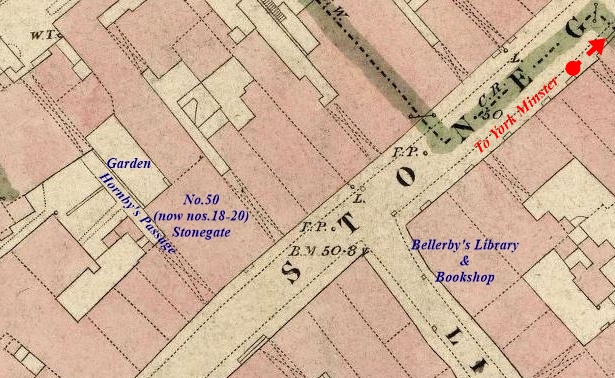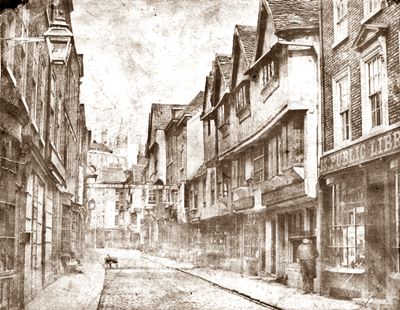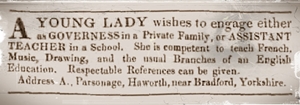|

Stonegate,
York c1849-52 © Beacon Dodsworth - the full map can be viewed HERE -
Stonegate is south of York Minster.
This part of York would have been well known to the Bronte siblings. Whilst
working at Mr Robinson's residence, Thorpe Green Hall, both Anne and her brother Branwell used
Bellerby's Public Library & Bookshop. Anne purchased books there and Branwell borrowed books
using Mr Robinson's account. Bellerby's was at no.13 Stonegate (now no.15), on the corner of Little
Stonegate, and about ten yards from the photographic studio which opened in September 1844.

Above: Stonegate, looking
towards York Minster from the junction of Little Stonegate in the 1850s with Bellerby's
Library & Bookshop to the right. At this point in time Stonegate was numbered
anti-clockwise 1,2,3,4, etc., starting and ending at St Helen's Square. It was
renumbered, probably in the 1950s or 1960s, with odd numbers on one side and even on the other. The
building which housed Bellerby's is now no.15, Stonegate and for some years has formed part of
Mulberry Hall which closed in March 2016: see York Press & YorkMix (external websites).
Charlotte's Jane Eyre by Currer Bell was
published in October 1847 followed in December by Emily's
Wuthering Heights by Ellis Bell &
Anne's Agnes Grey by Acton
Bell. The sisters
were very secretive. When the novels were published under these pseudonyms neither the public nor
their friends and family knew who the authors were. Even their father was completely unaware, despite the fact that the novels had
been written under his own roof. Charlotte only revealed the secret to him after reviews of Jane
Eyre had appeared.

By February 1848 the sisters' novels were listed in
Bellerby's circulating library (see advert) and
probably already available in their bookshop. Mr Bellerby would not have known that
one of the authors was one of his customers.
Further along from Bellerby's was no.17 Stonegate
(now no.23), the residence of William Charles Anderson, surgeon. He is mentioned, in
passing, in a letter dated 1852 from Charlotte to Ellen
Nussey. This is York Medical Society; his son was
Tempest Anderson (1846-1913).

Henry Bellerby also owned the Yorkshire Gazette
which had an office at no.13, Coppergate, York. In 1840, when the sisters were looking
for work as governesses or teachers, classified adverts were placed in this
newspaper. Branwell had some of his poems published in this newspaper in
1845.
|

